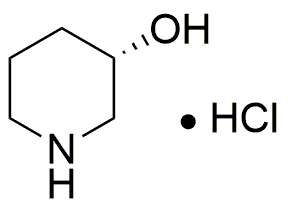(S)-3-Hydroxypiperidine hydrochloride is widely utilized in research focused on
- Pharmaceutical Development: This compound serves as a key intermediate in the synthesis of various pharmaceuticals, particularly in the development of drugs targeting neurological disorders.
- Chemical Synthesis: It is frequently used in organic synthesis as a building block for creating more complex molecules, allowing chemists to streamline their processes.
- Research in Neuroscience: The compound is valuable in neuroscience research for studying neurotransmitter systems and developing potential treatments for conditions like depression and anxiety.
- Biochemical Applications: Its properties make it suitable for use in biochemical assays, helping researchers understand enzyme activities and interactions in biological systems.
- Material Science: It can be incorporated into polymer formulations, enhancing the properties of materials used in various applications, including coatings and adhesives.
Información general
Propiedades
Seguridad y normativas
Aplicaciones
(S)-3-Hydroxypiperidine hydrochloride is widely utilized in research focused on
- Pharmaceutical Development: This compound serves as a key intermediate in the synthesis of various pharmaceuticals, particularly in the development of drugs targeting neurological disorders.
- Chemical Synthesis: It is frequently used in organic synthesis as a building block for creating more complex molecules, allowing chemists to streamline their processes.
- Research in Neuroscience: The compound is valuable in neuroscience research for studying neurotransmitter systems and developing potential treatments for conditions like depression and anxiety.
- Biochemical Applications: Its properties make it suitable for use in biochemical assays, helping researchers understand enzyme activities and interactions in biological systems.
- Material Science: It can be incorporated into polymer formulations, enhancing the properties of materials used in various applications, including coatings and adhesives.
Documentos
Hojas de datos de seguridad (HDS)
La SDS proporciona información de seguridad completa sobre la manipulación, el almacenamiento y la eliminación del producto.
Especificación del producto (PS)
La PS proporciona un desglose completo de las propiedades del producto, incluida la composición química, el estado físico, la pureza y los requisitos de almacenamiento. También detalla los rangos de calidad aceptables y las aplicaciones previstas del producto.
Certificados de análisis (COA)
Busque certificados de análisis (COA) ingresando el número de lote del producto. Los números de lote y de partida se pueden encontrar en la etiqueta de un producto después de las palabras "Lote" o "Lote".
Número de catálogo
Número de lote/lote
Certificados de origen (COO)
Este certificado de origen confirma el país en el que se fabricó el producto y también detalla los materiales y componentes utilizados en él y si se deriva de fuentes naturales, sintéticas u otras fuentes específicas. Este certificado puede ser necesario para cumplir con las normativas aduaneras, comerciales y regulatorias.
Número de catálogo
Número de lote/lote
Hojas de datos de seguridad (HDS)
La SDS proporciona información de seguridad completa sobre la manipulación, el almacenamiento y la eliminación del producto.
DownloadEspecificación del producto (PS)
La PS proporciona un desglose completo de las propiedades del producto, incluida la composición química, el estado físico, la pureza y los requisitos de almacenamiento. También detalla los rangos de calidad aceptables y las aplicaciones previstas del producto.
DownloadCertificados de análisis (COA)
Busque certificados de análisis (COA) ingresando el número de lote del producto. Los números de lote y de partida se pueden encontrar en la etiqueta de un producto después de las palabras "Lote" o "Lote".
Número de catálogo
Número de lote/lote
Certificados de origen (COO)
Este certificado de origen confirma el país en el que se fabricó el producto y también detalla los materiales y componentes utilizados en él y si se deriva de fuentes naturales, sintéticas u otras fuentes específicas. Este certificado puede ser necesario para cumplir con las normativas aduaneras, comerciales y regulatorias.


